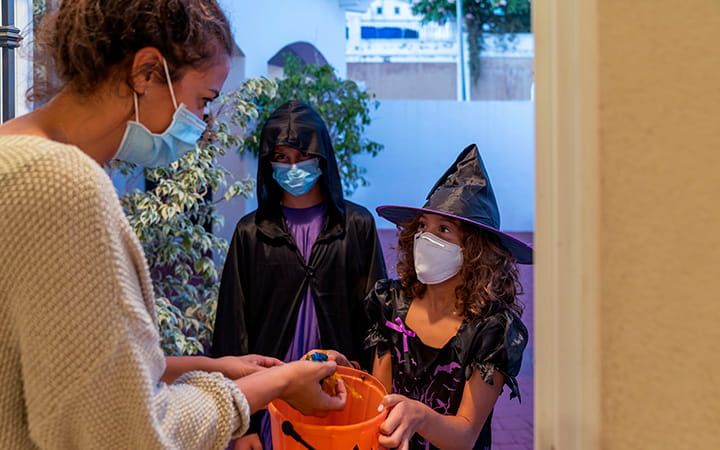How You Can Help Your Child Avoid Sugar Overload This Halloween
October 20, 2020
 University Hospitals Rainbow Babies & Children'sExperts in Children's Health
University Hospitals Rainbow Babies & Children'sExperts in Children's Health

A small amount of Halloween candy is not going to make or break a child’s weight or a parent’s dental bill. The problem is that for many families, it is not just one night of candy but many weeks' worth of candy bars, lollipops, toffee and more.
Excess calories play a role in children’s obesity and other health issues. While sugar and candy are only part of the problem, doing what you can to limit or avoid overload at Halloween is worth the effort.
These suggestions from Dominique Jones MS, RDN, LD, clinical pediatric dietitian at UH Rainbow Center for Women and Children, can help you make this holiday a bit healthier and safer. Yet they will not make your house the one kids avoid because you are handing out “healthy” stuff.
Keep Them Safe
- Feed your children a meal or snack before they head out. That will help keep them from munching on the treats they collect as they go door-to-door. Tell your children you need to inspect their goodies at home before they pop anything into their mouths.
- Discard all homemade candy or baked goods when your kids get home. Parents of toddlers should remove choking hazards such as gum, peanuts, hard candies, popcorn and the like.
- Inspect commercially wrapped treats for indications of tampering, like discoloration, tiny pinholes or tears in wrappers.
- Read ingredient labels with extra care if your child has food allergies.
Keep Them Healthier
Some treats are healthier than others. To focus on those:
- Opt for chocolate. Research has determined dark chocolate in particular is a rich source of antioxidants that has been linked to a reduced risk for heart disease and some cancers. And peanut butter cups at least have a little bit of peanut butter.
- Read labels with an eye toward lower fat, calories, sugar, sodium and trans fat totals. Snack size portions help to keep fat, sugar and sodium totals in check.
- Consider alternatives to candy. Offer single servings of mini boxes of raisins, microwave popcorn, string cheese, peanuts, ginger snaps, or crackers and cheese. Raisins, popcorn and peanuts are good options for kids older than age 3 (past the choking hazard stage.
- Offer healthy snacks too at your Halloween party. Try serving green goblin smoothies, colorful veggie platters, popcorn or fruit cut into fun Halloween shapes.
Tricks For Treats
Assuming you are going to let your children keep some of the candy they collect (you may have a riot on your hands if you take everything away), these tips can help moderate their intake:
- Set a portion size for each child. Let them know how much they are allowed to eat each day and when they can eat it. Freeze and dole it out over a longer period of time.
- Implement a “buy back” program. Let your children choose several of their favorite candies to enjoy. Then “buy” the rest of the candy in exchange for a special sleepover, toy, book or other treat. This allows your children to enjoy some of their candy without going overboard.
- Pair it up. When your child asks for some candy, pair it with something healthy like a banana, apple or nuts.
- Avoid buying Halloween candy too early. This helps your family to avoid additional candy eating before the holiday begins.
- Set a limit. Let your child have one snack-size piece per day, then put the rest away. A full size candy bar is 220 to 280 calories and three to four times the recommended daily allowance of sweets. A snack-size candy bar, at 75 to 100 calories, is the perfect amount for one day. The American Heart Association recommends we limit our added sugar intake to less than 25 grams per day for women and children and less than 36 grams per day for men.
- Mindfully enjoy your Halloween candy at the dinner table for dessert instead of in front of the TV. You will enjoy it more and avoid overeating.
- Offer a trade. Exchange your child's candy for a special toy or fun family outing.
- Skip sugary treats altogether. Hand out playful stickers, temporary tattoos, bouncy balls, yo-yos, colorful pencils or pencil toppers.
Related Links
UH Rainbow Babies & Children’s Hospital’s dedicated team of more than 1,300 pediatric specialists uses the most advanced treatments and latest innovations to deliver the complete range of pediatric specialty services for 750,000 patient encounters each year. Learn more about UH Rainbow Babies & Children's Hospital or find a pediatrician close to home.
Tags: Children's Health, Nutrition, Parenting


